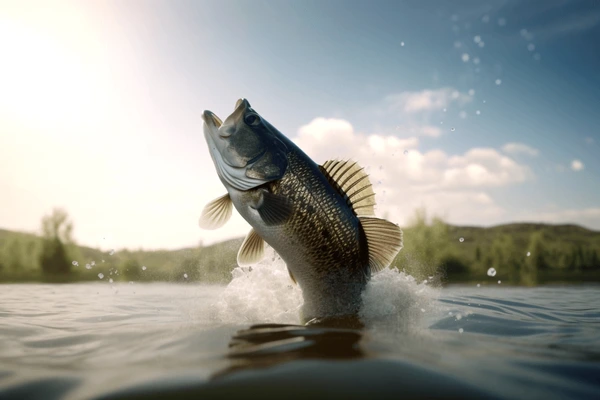Last Updated on July 15, 2022
- Best Bass Fishing Rods
- Best Bass Fishing Reels
- Bass Fishing Rod & Reel Combo
- Best Bass Lures
- Bass Fishing Rigs
Whether you’ve fished a few times or you’re still wet behind the ears, getting good at bass fishing isn’t as hard as you think.
When I first started fishing, I thought I would never catch on, and I’d be sitting there on the shore, casting for hours with nothing on the other end.
After a few hundred, then a few thousand casts, I started to catch on.
What really made a difference for me is when I started to learn more about how the bass behaves and how that impacts what we have to do to catch them.
Fishing is a lot like raising a child.
You can try all you want to force them to do what you want, but they’re still not going to do it.
You need to be smarter and manipulate them a little.
This comprehensive A to Z beginners guide contains more information than you ever thought you could know about bass fishing.
Go through it, come back later for more, and be sure to check back to the site every week for new and updated articles.
Table Of Contents
How to Catch Largemouth Bass
Where to Look
Fishing Techniques
Fishing by Season
Can You Eat It?
How to Cook It?
In my humble opinion, the largemouth bass is the epitome of freshwater fishing. There’s nothing better on the planet than the feeling of hooking a largemouth. They put up a heck of a fight, they strike hard, and they’re pretty good to eat too. Here’s everything you need to know about catching largemouth bass.
Where to Look
Let’s keep things simple here. The answer is you want to look at the shoreline. Whenever possible, largemouth bass will hold up along the shore and they’ll hold to any type of structure they can find in that area.
Largemouth Fishing Techniques
The best technique is a Carolina Rig and a soft plastic. There are few things that will entice a bass more than this because you’re basically bundling everything the bass wants into one presentation.
Your bait is free-floating, it’s presenting itself naturally, and if you’ve chosen the right pairing (a soft plastic) then it should look delicious to any nearby bass. In addition, the reflection of the ball and swivel will reflect the light in both clear and murky water which will draw even more attention and tick off the ornery bass.
Plus, you also have the beautiful action of a soft plastic worm flowing through the water while the weight maintains the bottom and ensures maximum accuracy and realism for your fake lure. This technique will work in most situations whether you’re fishing deep or shallow.
Now, if you’re really fishing deep for big lunkers you might want to pull out your crankbaits. These work great in depths of 20-feet or deeper in the middle of the day when the bass have moved out from the shallows.
Largemouth Fishing by Season
Let’s break down some of the best fishing techniques based on the time of year.
Spring
Spring largemouth season starts up around March or April depending on where you live. There are a few things to keep in mind about fishing this time of year.
First, bass has moved from the deeper water into the shallow now. They’ve done this because late Winter to early Spring is spawning season. The water will warm up faster in the shallow areas so it makes for the perfect location for spawning.
In a recent interview we did with Shaw Grigsby, he said his eyesight is the most important tool when fishing the spawn:
“I think some of it has to do with me being blessed with excellent eyesight,” Grigsby said. “But I’ve picked up little tricks along the way. For example, I like amber, yellowish sunglass lenses because they collect light and make it easier to see a fish moving or a shadow.”
Something I think that personally goes hand-in-hand with what Shaw said is the murkiness of the water. This might not impact the Florida waters as much but in the North, Spring is known for murky water which can really kill your ability to see anything. You’re dealing with a lot of runoff from melted snow and moisture in the ground.
All of this creates extremely murky water which means you need to be more aggressive with your presentation and choose spring bass lures that will shine or make noise because the bass won’t be able to see them otherwise.


